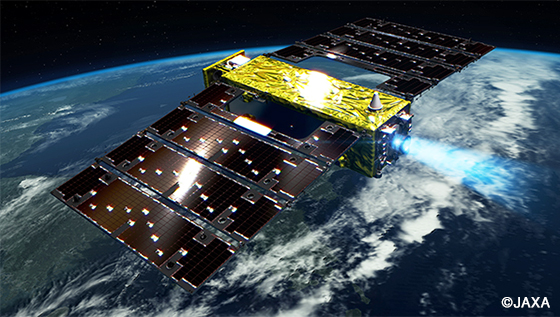
Mitsubishi Electric: Ion engine adopted: Ultra Low Altitude Test Satellite (SLATS)
Challenge to ultra-low altitude orbit:
There is a small amount of atmosphere at the orbital altitude (600-800km) of ordinary earth observation satellites.
Many earth observation satellites need to compensate for the decrease in orbit due to minute atmospheric resistance.
The altitude is maintained by injecting a gas jet on a regular basis.
Furthermore, in ultra-low altitude orbits (300-180km),
It receives about 1000 times more atmospheric resistance than the orbital altitude of 600 to 800 km.
Uses ion engine:
Therefore, “Tsubame” has adopted an ion engine that is 10 times more fuel efficient than a normal gas jet.
Due to small satellites with low atmospheric resistance
Maintain altitude continuously
We will take on the challenge of developing ultra-low altitude satellite technology.
http://www.mitsubishielectric.co.jp/society/space/satellite/observation/slats.html
JAXA | Super Low Altitude Test Satellite (SLATS) “TSUBAME” has set a GUINESS WORLD RECORDS(R)
1. Details on the Guinness World Record set by the Super Low Altitude Test Satellite “TSUBAME” (SLATS) URL:https://www.guinnessworldrecords.jp/world-records/592663-lowest-altitude-earth-observation-satellite-in-orbit
Name of record:
Lowest altitude by an Earth observation satellite in orbit
Record values: Orbital altitude of 167.4 km*2
Record Text: The lowest altitude by an Earth observation satellite in orbit is 167.4 km (104 mi) and was achieved by JAXA’s TSUBAME (JAPAN) during its mission from 23 December 2017 to 1 October 2019.
Further info: TSUBAME was a Super Low Altitude Test Satellite operated by Japan Aerospace Exploration Agency, or JAXA.
With its ion engine, TSUBAME
was able to capture high-resolution satellite images despite the atmospheric drag and density of atomic oxygen present in super low altitudes.
It maintained seven different orbital altitudes, with 167.4 km being the lowest.
At 167.4 km altitude, Tsubame used both its ion engine system and gas-jet thrusters.
2. Achievements made by “TSUBAME” (SLATS) and future prospects A super low altitude satellite has the merit of being able to take high resolution satellite images using a small sensor.
However, when in orbit at an altitude that is categorized as being super low—at an altitude between 200 km and 300 km—the satellite
will be exposed to 1,000 times more atmospheric resistance and concentrated atomic oxygen that would cause it to deteriorate as compared to other Earth observation satellites orbiting at the usual altitudes.
Thus, super low altitude
has been considered as being unsuitable for Earth observation satellites that require precise positioning, orbit control and long-term satellite operations.
“TSUBAME” first maintained an orbital altitude of 271.5 km, which was gradually lowered to finally reach the 167.4 km altitude that was recognized as a world record this time by the Guinness World Records.
This orbit in super low altitude was maintained for a period of seven days.
During its time orbiting in the record-breaking altitude, “TSUBAME” conducted tests on taking high resolution satellite images, and succeeded in obtaining good results.
The test satellite also succeeded in acquiring data of
atmospheric density,
atomic oxygen density, and
the level of deterioration of material samples
that were exposed to the atmosphere. Furthermore, the satellite also succeeded in demonstrating that the material developed by JAXA has the ability to withstand exposure to atomic oxygen for a long period of time.
https://global.jaxa.jp/press/2019/12/20191224a.html